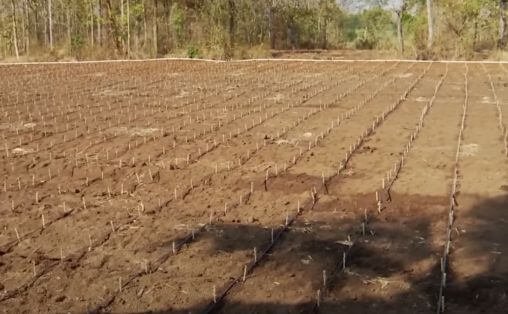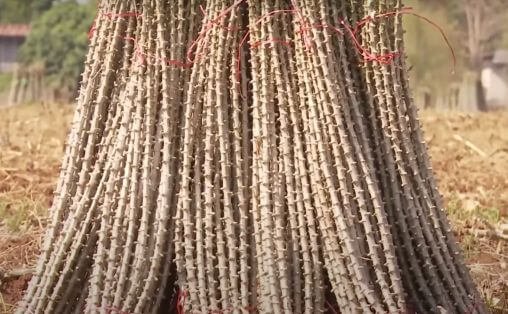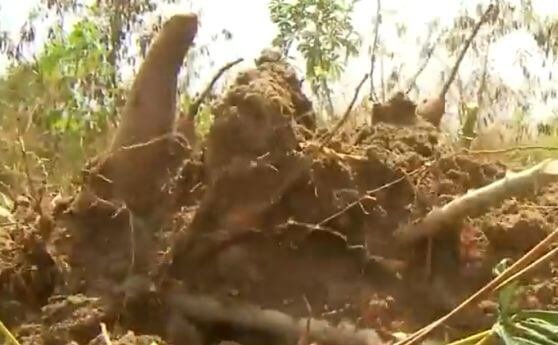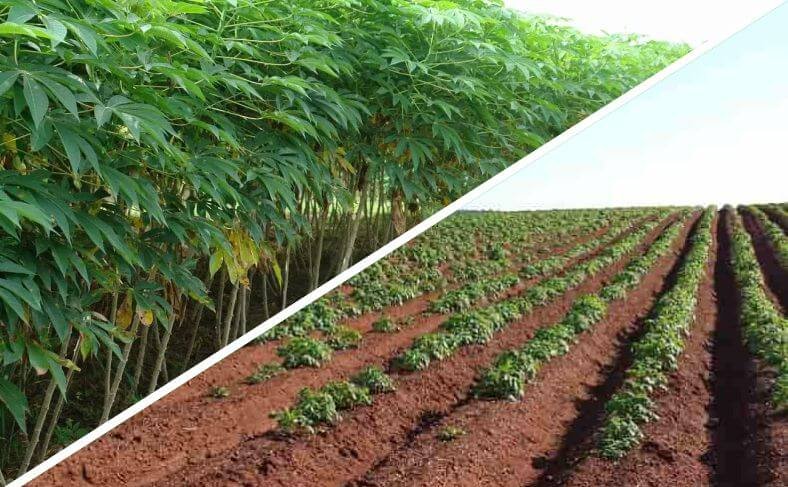Cassava farming and cultivation involve planting, managing soil, controlling pests and weeds, harvesting, and processing for food and the market.
Cassava, also called yuca or manioc, is a root crop grown widely for its starchy tubers.
Cassava farming gives you a steady path to food and income when you understand the core practices that guide its growth.
You begin by preparing your land, choosing healthy cassava stems, and planting them at the right time to make full use of soil moisture.
As the plants grow, you focus on simple but important tasks like weeding, spacing, and checking for pests and diseases.
Cassava responds well to care, even in dry or low-nutrient soil, which makes it a dependable crop for small and large farms.
As harvest approaches, you monitor the roots for size and age to get the best yield.
Proper handling after harvest protects the quality of the cassava roots and improves their value for processing into flour, starch, and feed.
This article guides new and seasoned cassava farmers into doing the right thing from the beginning to the end of farming.
Related: What is the Best Time to Plant Cassava?

Table of Contents
- What is Cassava Farming?
- Land Selection and Preparation
- Soil Testing and Fertility
- Planting Techniques
- Water Management and Irrigation
- Nutrient Management in Cassava Farming
- Categories of Cassava Farming and Cultivation
- Cassava Crop Management and Production
- Cassava Pests and Diseases
- Harvesting and Post-Harvest Management
- Cassava Processing and Value Chain
- Cassava Farming for Profit
- Mechanized Cassava Farming
- Challenges in Cassava Farming and Production
- Sustainable and Climate-Smart Cassava Farming
- Government Policies, Support, and Market Access for Cassava Farmers
- Conclusion
- Frequently Asked Questions
What is Cassava Farming?
Cassava farming and cultivation is the entire process of growing cassava, from land preparation and planting to maintenance, management, and harvesting.
It involves cultivating cassava in a variety of soil types and climates, especially in tropical and subtropical regions where the crop thrives.
Depending on resources and scale, farmers may use traditional methods that rely on manual labor or adopt modern practices that incorporate improved varieties, mechanized tools, and efficient farming techniques.
The goal is to produce healthy tubers for food, animal feed, or processing into products like flour, starch, or bioethanol.
Land Selection and Preparation
Successful cassava farming starts with choosing land that supports strong root growth.
You want a site with well-drained soil, full sunlight, and a pH between 5.5 and 7.0. While cassava grows in many soil types, loose loamy soil improves root expansion, drainage, and harvesting.
Avoid flood-prone or extremely dry areas because they limit yield and weaken root formation.
Begin by clearing weeds, shrubs, and debris using hand tools or machines.
After clearing, test the soil to check pH and nutrient levels.
The results tell you whether to add organic matter, lime, or fertilizer to balance nutrients like nitrogen, phosphorus, potassium, and essential micronutrients.
Large farms benefit from tractors and tillers, while small farms can manage with hoes, shovels, and rakes.
Plan irrigation in areas with inconsistent rainfall, as early moisture supports healthy root development. Ideal soil temperatures fall between 25–29°C.
Proper preparation gives cassava a strong start and sets the stage for efficient planting and long-term success. See a dedicated article on land preparation for cassava farming.
Related: Cassava Marketing Strategies for Profitability
Soil Testing and Fertility
Soil testing is the foundation of successful cassava farming, providing insight into nutrient levels, pH, organic matter, and macro and micronutrients.
By understanding your soil, you can create a fertilization plan tailored to your cassava crops, avoiding poor yields and inefficient fertilizer use.
Enhancing soil fertility involves using both organic and inorganic sources.
Organic manure improves soil structure, moisture retention, and microbial activity, gradually supplying nutrients.
Balanced fertilizers rich in nitrogen, phosphorus, and potassium support leafy growth, root development, and stress resistance.
Applying fertilizers based on soil test results boosts productivity while sustainable practices like crop rotation and cover cropping maintain long-term soil health.
Healthy, fertile soil strengthens resilience against pests and diseases, supports robust cassava growth, and ensures a productive and sustainable farming operation that maximizes yield and profitability over time.
While cassava can do well in most soil types, here are some requirements that can boost its yield from research.
See soil requirements for cassava cultivation.

Planting Techniques
Planting techniques determine how well your cassava crop establishes and grows.
Start by selecting healthy, disease-free stem cuttings that are 20 to 30 centimeters long with at least two nodes.
Using cuttings from mature plants reduces disease risk and supports vigorous root development, directly influencing yield.
Research institutes, such as the National Root Crops Research Institute (NRCRI), Umudike, can provide cassava stems to farmers.
These stems are often of high quality and are bred for specific traits such as disease resistance or high yields.
Private companies can also provide cassava stems to farmers. These companies often have large-scale cassava farms and can provide high-quality stems to farmers. See how to source cassava stems.
The orientation of the cuttings is important. See how to cut cassava stems here.
Plant them in a slanted position with one-third of the stem buried in the soil.
This allows roots to form efficiently and helps the plant access nutrients and moisture.
Timing is also key. Planting at the beginning of the rainy season ensures adequate water for root growth and sprouting. See the best time to plant cassava.
Spacing affects growth and productivity. Smallholder farms typically use one meter by one meter, while mechanized farms may use 0.8 meters by 0.8 meters. Here is the intra-row and inter-row spacing for cassava.
Proper spacing allows sufficient sunlight, air circulation, and nutrient availability for healthy cassava plants.

Choose the Right Planting Method
You can plant cassava directly in the field or use nursery transplants if that’s common in your area. The best method depends on your climate, land type, and tools.
Whichever you choose, make sure the soil is loose and rich with organic matter so roots can grow freely.
Related Posts
- The Cassava Industry
- Guide to Cassava Processing Machines and Tools
- Crops to Intercrop with Cassava
- Introduction to Cassava Processing
- Varieties of Cassava Stem and Propagation
- Cassava Entrepreneurship
- The Ideal Climate Conditions for Cassava Farming
- Setbacks in the Cassava Value Chain
- How to Know Cassava is Ready for Harvesting
- Environmental Impact of Cassava Cultivation
Water Management and Irrigation
Proper water management is essential for growing healthy cassava. Maintaining the right soil moisture throughout the crop’s growth supports root development and prevents stress caused by drought or water logging. Paying attention to irrigation ensures your cassava plants thrive and produce better yields.
Drip Irrigation
Drip irrigation delivers water slowly and directly to the root zone of each cassava plant, ensuring even moisture distribution without saturating the soil. This method reduces evaporation, conserves water, and prevents water logging that can cause root rot or fungal infections. By controlling the timing and quantity of water, you can support root initiation and tuber expansion, particularly during critical growth stages between three to six months. Drip systems also allow for easy integration of liquid fertilizers, promoting nutrient absorption. With careful installation and maintenance, this technique enhances plant health, optimizes growth, and increases yields on both small and large farms.
Furrow Irrigation
Furrow irrigation involves creating shallow trenches along the cassava rows and channeling water through them to reach the root zone. This traditional method allows water to seep gradually into the soil, supporting root growth while limiting waste. Proper planning is essential to prevent flooding, as excess water can suffocate roots and encourage diseases such as root rot. Furrow irrigation works best on gently sloping fields and requires monitoring to maintain uniform moisture levels. Farmers can adjust water flow based on soil type and rainfall. When executed carefully, this method is cost-effective, supports large-scale planting, and ensures adequate moisture for cassava tuber development throughout the season.
Soil Moisture Monitoring
Monitoring soil moisture is vital to ensure cassava receives consistent water without overwatering. Devices such as tensiometers or soil moisture sensors give real-time data on soil water content, helping you make precise irrigation decisions. By knowing the exact moisture levels, you can irrigate only when necessary, preventing stress during drought and avoiding water logging that promotes fungal and bacterial infections. This approach also helps in managing irrigation schedules for different soil types and field zones. Combining moisture monitoring with proper drainage ensures roots remain aerated and healthy, directly improving cassava growth, tuber size, and overall yield potential, making farming more efficient and sustainable.
Nutrient Management in Cassava Farming
Fertilizing your cassava plant is also essential for healthy growth. Organic fertilizers, made from plants or animal sources, improve soil health over time.
Effective nutrient management is key to achieving healthy cassava plants and high yields. Focusing on macronutrients like nitrogen, phosphorus, and potassium, along with essential micronutrients such as magnesium, calcium, and sulfur, supports proper growth and development. Nitrogen promotes leafy growth necessary for photosynthesis, phosphorus aids in root establishment and energy transfer, and potassium improves water regulation and stress resistance. Micronutrients, though needed in smaller amounts, are vital for processes like chlorophyll synthesis and cell wall stability.
Timing of fertilizer application is critical. Split applications, applied at planting and during key growth stages like root establishment and tuber formation, allow plants to absorb nutrients efficiently. This approach reduces nutrient loss, strengthens plant health, and improves productivity, ensuring your cassava farming operation is both profitable and sustainable.
Categories of Cassava Farming and Cultivation
Cassava farming and cultivation are divided into three main categories: small-scale, large-scale, and commercial.
Small-Scale Cassava Farming
Small-scale farmers cultivate yuca for subsistence purposes – for their own use, using traditional farming techniques such as a hoe, shovel, and other local farming equipment, and rely solely on family effort and labor.
Large-Scale Cassava Farming
Large-scale farmers use relatively more advanced farming tools, techniques, and equipment, including tractors and irrigation systems, to increase yield.
Commercial farmers, on the other hand, produce cassava for sale in local or international markets. Read an in-depth guide on commercial cassava farming.

Cassava Crop Management and Production
The production of cassava involves a chain of steps before it is used to produce its numerous products and reaches the final consumer.
Managing your cassava crop correctly is the key to ensuring a healthy harvest. Without proper care, your plants may struggle to grow, leading to lower yields.
One of the most important steps is controlling weeds. Weeds can steal nutrients, water, and sunlight from your cassava plants, so it’s crucial to keep them in check.
Weed Control Methods
To control weeds, you can use several methods: mechanical weeding, manual removal, or even cover crops.
For larger fields, mechanical weeding is a great option because it saves you time and labor.
Cover crops, like legumes, can also suppress weeds and improve soil fertility, making your soil more fertile for cassava growth. See more on cassava weed management.
Mulching for Better Growth
Mulching is another effective technique. By applying organic or plastic mulch around your cassava plants, you can keep the soil moist, which reduces the need for constant irrigation.
In addition, mulch helps stop weeds from growing and adds nutrients to the soil as it breaks down, improving your plants’ overall health and boosting your yield.
Intercropping to Maximize Land Use
Consider intercropping, and growing cassava alongside other crops. This helps you make the most of your land, increases biodiversity, and may improve pest management.
Intercropping cassava with legumes, for example, can enrich the soil with nitrogen, a natural nutrient that benefits your cassava plants.
You can also practice crop rotation to maintain healthy soil and keep pests in check.
Here is more on intercropping cassava.
Cassava Pests and Diseases
Cassava faces multiple pests and diseases that can affect its yield and quality. One major threat is the cassava mosaic virus, which causes leaf distortion and reduced tuber production.
To combat this, using disease-free cuttings and practicing crop rotation are key prevention strategies. Mealybugs, which feed on plant sap, can damage cassava plants.
Natural predators like ladybugs, along with neem oil treatments, can effectively control these pests while remaining eco-friendly.
Bacterial blight leads to leaf spots and defoliation, especially in humid conditions. Ensuring good sanitation, such as sterilizing tools and promoting proper drainage, helps prevent its spread.
Additionally, planting resistant cassava varieties offers an effective control measure. By combining cultural, chemical, and biological strategies, farmers can safeguard cassava crops.
Regular monitoring and prompt intervention are essential to maintaining healthy yields and protecting the crop.
See a dedicated post for cassava pests and diseases.
Harvesting and Post-Harvest Management
Harvesting cassava roots at the right time ensures optimal yield and quality. Cassava is typically ready for harvest 10 to 12 months after planting.
Indicators of maturity include yellowing leaves and roots at least 2 inches in diameter. Healthy foliage and a strong stem structure also suggest readiness.
During harvesting, use a sharp spade or machete to gently loosen the soil around the roots, avoiding damage.
Once exposed, roots should be carefully pulled from the ground and cleaned of excess soil. Post-harvest, cassava should be stored in a cool, shaded area to prevent spoilage.
If not processed immediately, store the roots in a well-ventilated space, maintaining proper moisture levels to avoid decay or dehydration. Here is an in-depth guide on harvesting cassava roots.
Post-harvest management in cassava farming determines the quality, shelf life, and market value of your harvest.
Proper handling after harvesting can reduce losses, maintain root quality, and increase profitability.
Washing and Cleaning Roots
After harvesting, wash cassava roots thoroughly to remove soil and debris. Clean water and careful handling reduce microbial contamination, prevent early spoilage, and improve appearance. Gentle scrubbing and avoiding bruising during cleaning maintain the integrity of the roots, ensuring they remain healthy for storage or processing.
Grading and Sorting
Sorting cassava roots by size, shape, and condition helps maintain quality. Remove damaged or infested roots to prevent spoilage. Proper grading ensures you present the best product to the market, which can positively affect pricing and consumer trust.
Storage and Value Addition
Store roots in a cool, dry place to prolong shelf life. For longer storage, consider cold storage or processing into flour and starch.
Processing not only preserves the cassava but also increases income opportunities by creating value-added products. Proper post-harvest management maximizes yield benefits and market potential.
As soon as cassava is harvested and left above ground, it starts the fermentation process, which is why an effective storage technique is necessary.

Cassava Processing and Value Chain
Cassava processing boosts its economic value and offers diverse products for various market demands along the value chain.
Common processed cassava products include gari, cassava flour, starch, and ethanol.
Gari, a popular fermented and fried product, is widely consumed in Africa and helps reduce post-harvest losses.
Cassava flour, known for its gluten-free properties, is an alternative to wheat flour, appealing to health-conscious consumers.
Cassava starch, used in food and non-food industries, plays a key role as a thickening agent in products like textiles and paper.
Additionally, cassava is gaining recognition for biofuel production through ethanol fermentation, offering a sustainable energy source.
Processing cassava also promotes rural development by creating jobs and strengthening local economies, ensuring greater profitability and sustainability for farmers.
Cassava Farming for Profit
Cassava farming offers a profitable opportunity, thanks to its widespread use as a staple food and its ability to produce various products.
A well-managed cassava farm can yield between 10 to 20 tons of tubers per hectare annually, with optimal conditions boosting yields even higher.
Initial investments include land preparation, planting materials, labor, fertilizers, and pest control, typically costing $300 to $1,200 per hectare.
However, gross revenues can reach up to $3,000 per hectare, offering attractive returns.
Farmers must account for recurring expenses such as maintenance, harvesting, and transportation to assess profitability.
Overcoming challenges like pests, diseases, and market fluctuations is essential for sustainability.
Diversifying production, adopting high-yield varieties, and processing cassava into products like flour or chips can further increase profitability, making cassava farming a potentially lucrative business.
See our comprehensive post on commercial cassava production.
Mechanized Cassava Farming
Mechanized cassava farming has transformed traditional practices, boosting efficiency and productivity by integrating modern machinery into various stages of cultivation. This approach allows you to manage large-scale farms more effectively, saving time and labor while improving crop performance.
Tractors and rotavators enhance land preparation by tilling the soil thoroughly, improving aeration and structure for optimal root development. Mechanical planters ensure precise planting depth and spacing, promoting uniform growth and maximizing yield potential. These machines accelerate planting, reduce labor costs, and help every plant thrive in its designated space.
Specialized cassava harvesters simplify the extraction of roots, minimizing physical labor and damage to the tubers. They can handle different soil types while maintaining root quality. Mechanization enables higher productivity, supports sustainable farming, and equips you to meet increasing market demands efficiently.
Challenges in Cassava Farming and Production
Despite its importance as a food crop, cassava farming and production face several challenges:
1. Climate change: Climate change is increasing the frequency and severity of droughts, floods, and other extreme weather events, which can hurt cassava yields.
2. Pests and diseases: Cassava is susceptible to a variety of biotic factors – pests and diseases, including cassava mosaic disease, cassava brown streak disease, and cassava green mite. These can cause significant crop losses if not properly managed.
3. Postharvest losses: Cassava roots are highly perishable and can spoil quickly after harvesting. Improper handling and storage can lead to significant postharvest losses.
4. Processing challenges: Processing cassava to remove toxins and prepare it for consumption or further processing can be time-consuming and labor-intensive, especially for small-scale farmers.
5. Market access: Many cassava farmers, especially small-scale farmers, face challenges in accessing markets for their products. Poor infrastructure, lack of market information, and low prices can make it difficult for farmers to sell their crops.
Addressing the Challenges
To address these challenges, it is important to invest in research and development to develop new cassava varieties that are more resilient to climate change and pests and diseases.
Improving postharvest handling and storage practices can also help reduce losses and increase the availability of cassava products.
Strengthening market linkages and improving infrastructure can help farmers access better prices and increase their incomes. See more on challenges facing the cassava value chain and solutions.
Sustainable and Climate-Smart Cassava Farming
To maintain high yields while protecting the environment, adopting sustainable farming practices is key.
Water-Efficient Techniques
Using water-efficient methods is essential for boosting cassava production without wasting precious resources.
Drip irrigation delivers water directly to the roots, cutting down on evaporation and runoff. Rainwater harvesting helps capture water during wet periods for use in dry spells.
Mulching also plays a role in preserving soil moisture, preventing erosion, and controlling weeds, all of which improve crop health.
Zero-Waste Approach
A zero-waste strategy can further increase sustainability in cassava farming. By utilizing all parts of the plant, from roots to leaves, farmers can reduce waste.
Cassava leaves can be used as food or animal feed, while peels can be processed into biofuel or organic fertilizer.
Incorporating these climate-smart practices can make cassava farming both profitable and environmentally responsible.
By using efficient methods and reducing waste, you can create a sustainable and profitable farming operation that meets both economic and environmental needs.
Government Policies, Support, and Market Access for Cassava Farmers
Cassava farming is a key part of agriculture in many countries, with government support playing a major role in boosting productivity and sustainability.
Through financial assistance such as grants, loans, and subsidies, governments help farmers meet the costs of production and improve their yields.
Since cassava is both a food source and a cash crop, these policies are designed to encourage growth in this sector.
Cooperatives and Resource Sharing
Government-backed cooperatives are an effective way for cassava farmers to pool resources, share knowledge, and secure better deals with buyers.
By working together, farmers can increase their bargaining power, improve yields, and reduce costs.
These cooperatives also make it easier to access new tools and technologies that can improve farming practices and productivity.
Improving Market Access
Market access is another area where government support is crucial.
Governments help identify potential buyers and export markets, often through trade agreements that lower tariffs and make it easier to sell cassava products abroad.
Policies promoting cassava-based products, such as flour and starch, open new revenue streams.
Additionally, investment in infrastructure, such as better roads and storage facilities, ensures that farmers can transport their products to markets efficiently.
In short, government support in the form of policies, financial aid, and market access plays a key role in helping cassava farmers grow their businesses.
By taking advantage of these resources, farmers can boost their productivity and tap into new markets, contributing to both food security and economic stability.
Conclusion
Cassava farming is an essential agricultural practice that feeds millions and drives income for farmers across tropical and subtropical regions.
Its versatility, thriving in poor soils with minimal rainfall, makes it a vital crop for rural farming communities.
To succeed, farmers must understand cassava’s soil requirements, planting techniques, and proper management.
This includes selecting disease-free stems, ensuring correct planting times, and applying the right spacing for growth.
Challenges such as pests and diseases must also be managed through preventive measures like crop rotation and the use of resistant varieties.
Cassava’s market demand for products like gari, flour, and bioethanol further enhances its profitability, making it a rewarding venture for both small and large-scale farmers.
Frequently Asked Questions
What are the basic requirements for successful cassava farming?
Successful cassava farming needs well-drained soil, disease-free stems, correct spacing, steady moisture during early growth, weed control, and timely fertilization to support healthy root development and higher yields.
When is the best time to plant cassava stems?
Plant cassava at the beginning of the rainy season to help stems establish quickly. Adequate early moisture boosts sprouting, root formation, and overall crop performance.
How can farmers control pests and diseases in cassava fields?
Control pests and diseases using resistant varieties, clean planting materials, crop rotation, field sanitation, and regular monitoring to catch early infections before they reduce yield.
What determines cassava yield at harvest?
Cassava yield depends on stem quality, soil fertility, moisture levels, spacing, weed control, and timely harvesting. Good management from planting to maturity ensures stronger tubers.
References

